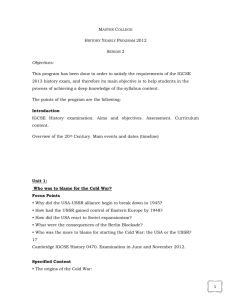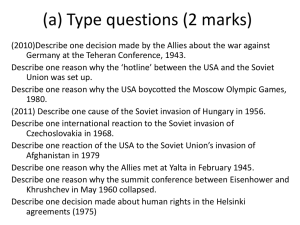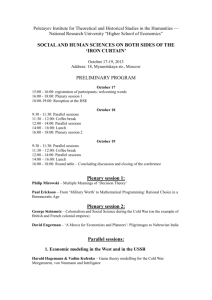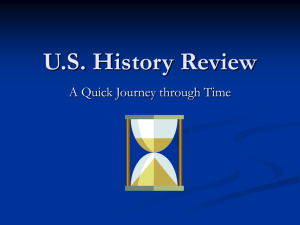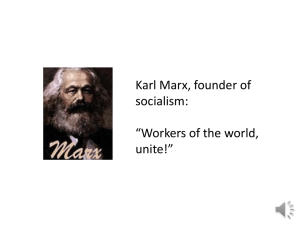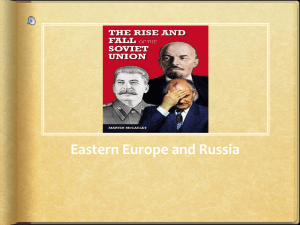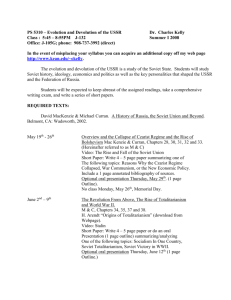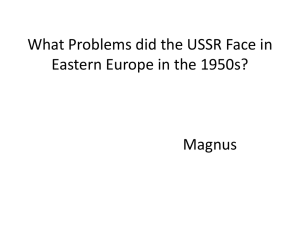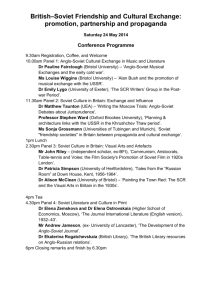6 The End of the System
advertisement
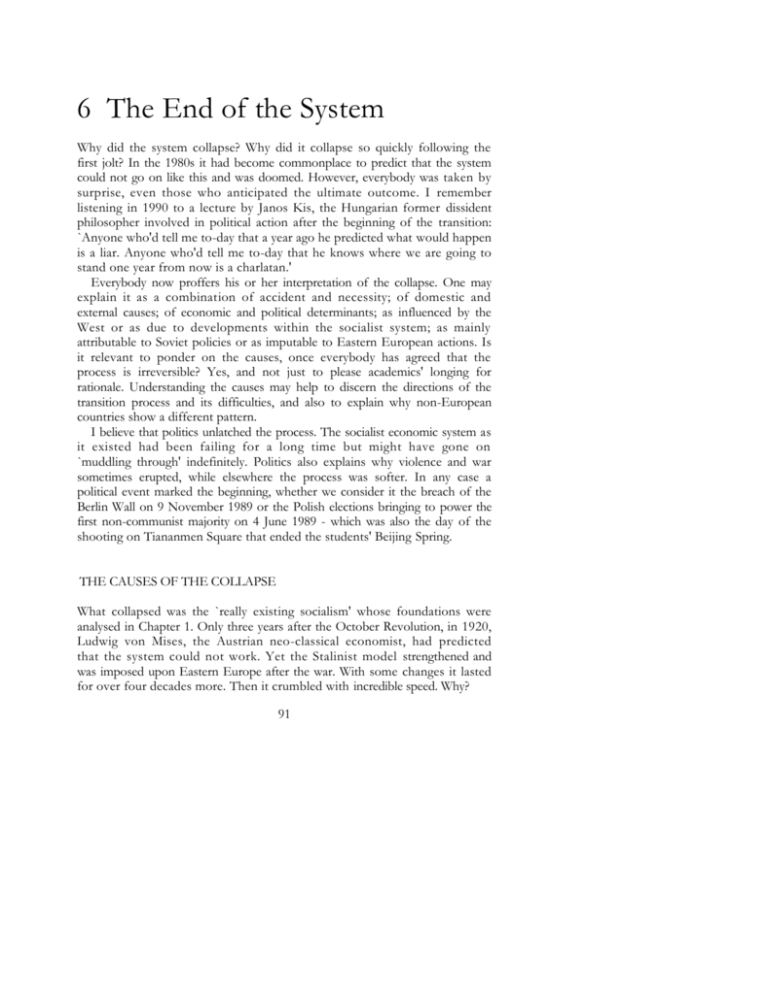
6 The End of the System Why did the system collapse? Why did it collapse so quickly following the first jolt? In the 1980s it had become commonplace to predict that the system could not go on like this and was doomed. However, everybody was taken by surprise, even those who anticipated the ultimate outcome. I remember listening in 1990 to a lecture by Janos Kis, the Hungarian former dissident philosopher involved in political action after the beginning of the transition: `Anyone who'd tell me to-day that a year ago he predicted what would happen is a liar. Anyone who'd tell me to-day that he knows where we are going to stand one year from now is a charlatan.' Everybody now proffers his or her interpretation of the collapse. One may explain it as a combination of accident and necessity; of domestic and external causes; of economic and political determinants; as influenced by the West or as due to developments within the socialist system; as mainly attributable to Soviet policies or as imputable to Eastern European actions. Is it relevant to ponder on the causes, once everybody has agreed that the process is irreversible? Yes, and not just to please academics' longing for rationale. Understanding the causes may help to discern the directions of the transition process and its difficulties, and also to explain why non-European countries show a different pattern. I believe that politics unlatched the process. The socialist economic system as it existed had been failing for a long time but might have gone on `muddling through' indefinitely. Politics also explains why violence and war sometimes erupted, while elsewhere the process was softer. In any case a political event marked the beginning, whether we consider it the breach of the Berlin Wall on 9 November 1989 or the Polish elections bringing to power the first non-communist majority on 4 June 1989 - which was also the day of the shooting on Tiananmen Square that ended the students' Beijing Spring. THE CAUSES OF THE COLLAPSE What collapsed was the `really existing socialism' whose foundations were analysed in Chapter 1. Only three years after the October Revolution, in 1920, Ludwig von Mises, the Austrian neo-classical economist, had predicted that the system could not work. Yet the Stalinist model strengthened and was imposed upon Eastern Europe after the war. With some changes it lasted for over four decades more. Then it crumbled with incredible speed. Why? 91 The Present: Transition in the Making The Roots If one looks at the way the actually existing socialism operated, once the political terror was lifted following Stalin's death there were plenty of reasons explaining why the system should collapse; but it didn't; so the question is, what made the system last? Inherent economic flaws For more than thirty years the communist leaders have been warning that the system was working inefficiently and that reforms were needed, with the well-known phrases about `improving planning and management', 'increasing productivity', `shifting to an intensive growth policy'. Western experts agreed on the inefficiency symptoms; they disagreed on the feasibility of a reform. The following symptoms, or imperfections as they were usually called in the Eastern official parlance, were usually mentioned: - growth was declining; - productivity of labour and capital was low; output per worker was decelerating over time, and output per unit of fixed assets dramatically declined, especially after the mid-1970s; - technical progress was implemented slowly, even when available, and the lag with the West was growing; - the military buildup was absorbing a large part of the GNP, especially in the USSR where the CIA estimates put it in the range of 16 per cent in the 1980s; - in the USSR, the agricultural sector remained backward despite gigantic investments, and could not provide food self-sufficiency; - the standards of living and consumption were mediocre. Such a state of affairs was explained by policy errors, and also by the external environment, of which the components were: the oil shocks (in the case of Eastern Europe this had entailed foreign trade deficits and a growing indebtedness: in the case of the USSR it had, on the contrary, created a bonanza that had dispensed with serious reforms); the Western recession that had made access to Western markets more difficult. The external political environment of the post-detente era was quoted as well. The Eastern analysts underlined the stiffening of high technology export controls; the Western experts stressed the military buildup in the USSR which increased the share of military expenditures in the budget and the GNP and prevented any improvement in the consumption level. The End of the System 93 By 1985, just before the accession of Gorbachev to power, the Western experts offered several scenarios, referring to the trends that were then observed (cf. Chapter 3): - continuing inadequate reforms as in the USSR, leading to stagnation or to an open crisis; - the strengthening of conservative trends in the GDR and Czechoslovakia, with only cosmetic reforms leaving the central planning system intact; the system seemed more viable here due to a better standard of living than anywhere else in the East, and to better conditions for modernization sustained by powerful industrialist lobbies; - market-oriented reforms in Hungary, Poland and to a lesser degree in Bulgaria, stopping short of actually introducing the market and discarding the plan and the bureaucracy; - the status quo, for atypical cases such as the `communism in one family' in Romania, where the populace was, amazingly to Western eyes, enduring the hardships imposed on it by the regime. Albania could be ranked among the last remnants of the Stalinist regime as well; - finally, uncertainty in the case of Yugoslavia, a fake market economy, just enough committed to reforms to benefit from IMF package s, politically controlled by a very authoritarian party whose power was challenged by national-ethnic disputes; an expert aptly named it `feudalised socialist mercantilism' (Rusinow, 1989, p. 59). The global outlook, or most probable baseline scenario, has been summed up by the late Ed Hewett, exactly as most of his colleagues would have viewed it (Hewett, 1989, p.4): `some reforms, and some changes in policy, both of which have a positive effect on performance; but nothing bold or terribly decisive. It amounts to "muddling through" with sufficient flexibility to avoid the most treacherous pitfalls, but with sufficient conservatism so that the more dramatic possibilities for improving the situation remain unexplored.' Obviously there are many good reasons for explaining post factum why the system could only collapse. Among many others, a synthetic exposition may be found in Easterly and Fisher (1994). Both authors deride the very `mistaken' assessment expressed in The Soviet Economy: Toward the Year 2000 (Bergson and Levine, 1983), according to which there was scope for reform and resumption of growth in the USSR. They contend that the clue to the Soviet collapse must be found in the systemic inability to substitute capital for labour: thus, while capital was growing, labour force per unit of capital was not declining, and hence the rate of return to new investment had to decline to a level of near zero by the mid-1970s. Apart from the fact that this looks like a rather trivial explanation (besides, the point had been made earlier, and the authors pay tribute to Martin Weitzman for it; they The Present: Transition in the Making claim that recently available data make it the more convincing), we still remain with the question: why did the collapse occur so late? Political and social causes The economic situation in itself could not explain why the whole system collapsed at a given point. Are, then, specific social and political reasons to be found? It is not enough to say that the society had lost any trust in the regime. This had happened long ago. Communism did not represent moral values any more. The corrupted ruling class was despised; people saved their forces and efforts for themselves, and any attempt to `mobilise' them for the socialist sector could only misfire. Western influences are sometimes put forward to explain the collapse of communism. The masses began to have an idea of a `civil society' and aspired to it. Again, this was not new. They had developed an idealised image of Western society through travelling to the West and from Wester n tourists, TV, and radio broadcasts. All these channels were not so easy to get to, but all the more effective. What spark set the fire ablaze? The Start The socialist economic system rested upon the monopoly of the party. Hence a breach in this monopoly triggered the collapse. It had to happen in the USSR. Whatever their disputes, the communist parties were linked by their solidarity for survival. When the legitimacy of the Soviet communist party was allowed to be questioned in the USSR, and when the Soviet party renounced support of that legitimacy in the `brother' countries, any spark could set the fire. That happened soon after Gorbachev came to power. Perestroyka Though the last stage of the Soviet reform, called perestroyka or restructuring, raised immense hopes, it is not very relevant now. The economic programme launched by Gorbachev was remarkable for its weaknesses. (1) Two blunders were made at the start in 1985-6. First, the proclaimed antialcoholic campaign was fighting just one sign of public loss of morale; it incensed the people, generated crime, made speculators richer and the state poorer. Second, the catchphrase of `stepping up growth' was strongly reminiscent of Stalinist parlance. Of course the external and internal situation had deteriorated: the people felt that it was only too easy to invoke at the same time the bad harvest of 1985, the Chernobyl catastrophe of 1986 and the fall in world oil prices, to demand an exceptional effort. (2) Perestroyka was announced in 1985, really launched in 1987, and stopped short of any radical change. In 1987 the enterprises got more rights The End of the System but remained under central command through the so-called `state orders' which were central planning in disguise. Private ownership was not legally acknowledged. So-called `individual activities' were supposed to be a substitute for private enterprise; their scope was very limited. The new law on cooperatives (1988) offered greater opportunities to entrepreneurship but these were mainly used in the services sector to launder mafia money. The leasing contract (arenda) in agriculture did not motivate the small minority of would-be farmers on their own, who dreaded a reversal in policy and the hostility of the other peasants. Endless administrative restructuring that was meant to simplify bureaucracy in fact created additional red tape. (3) Ineffectual as it was, perestroyka however managed to destabilise the Soviet economy and to create an open crisis situation in 1989. While prices remained fixed, inflationary pressures mounted, and the word `overhang' became largely used to denote the gap between effective demand and available supply at fixed prices. The budget deficit was increasing, and rationing was being introduced in the big cities. At the end of 1989 the first stabilisation and reform blueprint was made public. This programme drafted by the minister in charge of reform, the economist and academician Leonid Abalkin, was to be followed by many others (see next chapter, Box 7.1). (4) Perestroyka did not imply abandoning either socialism as an ideology, or the party monopoly, though Gorbachev undertook to massively replace the party cadres. Western economists strongly criticised the concept of `regulated market socialism' which expressed that stance. Glasnost G l a s n o s t is a political concept that is hard to render in one word. Usually it is translated in English as `openness' (Nove, 1992, p. 395) or `public disclosure' (Lapidus, 1991, p. 1 4 1 ), with authors however feeling that it should be explicated. Thus it is described as `a freeing up of access to information, the gradual erosion of censorship, and the progressive elimination of taboos on subjects that had previously been impossible to discuss in the mass media' (Dallin and Lapidus, 1991, p. 3), or `encouragement of more open expression in public communication in order to mobilise support for the reform programme' (Remington, 1991, p. 97), or `freedom of criticism, discussion and publication' (Nove, 1992, p. 396). In the field of economics glasnost had an immediate impact on the overall performance of Soviet workers. Their already low productivity went on decreasing as they were increasingly immersed in reading the papers and watching the television during working hours. Political pluralism was introduced in 1990 and the party's monopoly on power was ended explicitly in February 1990. However its implicit ideological monopoly was ended only in 1991, following the failed 19 August coup against Gorbachev. It is 96 The Present: Transition in the Making not so easy to date the moment when Gorbachev decided that the Soviet party would no longer interfere with the political changes in the brother countries' parties. In any case the process began with a double abstention. The Soviet party did not condemn the so-called `Round Table' negotiations, which opened in February 1989, between the Polish leadership and the opposition represented by Lech Walesa, the president of Solidarity. It did not block the progress toward multipartism in Hungary which had begun in the first months of 1989. The transition could start. Is this analysis exaggerating the 'Gorbachev factor'? One may also turn things differently. The Soviet communist party was no longer interested in its economic domination in Eastern Europe because the situation in the USSR had become economically and politicall y critical. The communist power then collapsed in Eastern Europe because it derived its legitimacy from the USSR, beginning with the countries - Poland and Hungary - where this power was already most eroded. THE FIRST STEPS OF THE TRANSITION: CENTRAL EUR OPE Table 6.1 shows the stages of the political revolution in Eastern and Central Europe, which preceded economic transition. While in Part I we have merged all these countries in the phrase `Eastern Europe', from now onwards we are going to differentiate among groups. One country will shortly go out of our focus. This is the GDR, which has been absorbed into the Federal Republic of Germany. The first circle of the transition comprises three countries of Central Europe: Poland and Hungary, soon joined by Czechoslovakia following the `velvet' Revolution in November 1989. The second circle includes the Eastern European countries proper, a designation which we prefer to that of `Balkans': Romania, Bulgaria, Albania, parts of the former Yugoslavia, to be joined in 1993 by Slovakia. (See Table 6.2 for the new geopolitical picture of the former communist Eastern Europe.) The case of the USSR will be discussed in the next section devoted to the final collapse of the socialist system. The GDR: A Merger The GDR was a symbol of maximum communist rigidity, and also of what could be called a `success story' within the communist camp. It lost its political and economic identity in less than one year following the breach of the Berlin Wall (9 November 1989), first when the economic and currency union was implemented on 1 July 1990, then when the political union was decreed on 3 October 1990. The GDR became the five new provinces, 'Neue Lander', of united Germany. The area faced the same stabilisation and restructuring problems as the other countries. The German government The End of the System 97 swiftly moved on the stabilisation front (in fact the currency union was the most radical instrument of macroeconomic policy) and on privatisation. The latter was tackled by an ad hoc institution, the Treuhandanstalt, a stateowned holding company whose task was to restructure and sell East German assets or else to close the enterprises down, a process to be completed by end1994. The Western part of the country devoted more effort to this task and many more funds than the total assistance made available to the remaining countries in transition. Apart from the financial burden, the material losses were huge: a large share of the productive capacities were simply dismantled as obsolete and harmful to the environment. Human costs were to be large as well: while the GDR population had one of the highest activity rates in the world (the share of working population to total population of working age was over 80 per cent in 1989), the rate of unemployment had already reached 10 per cent of the labour force in 1991. The developments within the New Lander are not going to be elaborated upon hereafter. The GDR is no longer a state, and it is no longer part of the East. Its transition has been a unique experience. Two lessons may be derived from this experience for the other countries in transition. First, even with favourable conditions such as extensive access to finance and expertise, the transition was painful for the East Germans: many lost their jobs and suffered a decline in their standard of living. Second, the transition process bypassed them: they did not take the decisions, and a very small part of the assets in their region could be recovered by them in the short run. The East Germans thus shifted from the paternalistic rule of the communist state to the paternalistic control of the capitalist state-and-business establishment. The PHARE Countries In Jul y 1989, during the Summit of the G -7 (the group of the 7 most industrialised countries in the world), it w as decided to empower the Commission of the European Communities with the coordination of assistance to Poland and Hungary. At a time when the transition was not yet perceived as irreversible, the purpose was to strengthen the commitment of both countries to building democracy and a market economy. The Commission then launched a programme called PHARE. (PHARE is originally a French acronym meaning: Pologne, Hongrie, Assistance a la Restructuration Economique. It may easily be transposed into English: Poland, Hungary, Assistance to the Restructuring of the Economy.) Both countries were clearly designated as the most advanced in their progress toward these aims. In 1990 other countries were added to the PHARE list: Czechoslovakia, Bulgaria, Yugoslavia, later Romania. The first two recipients of the PHARE aid kept their lead, at least in terms of total assistance received. Czechoslovakia claimed to be part of the leading group Table 6.1 The stages of the political Countries: Stages of the political revolution: Bulgaria revolution in Central and Eastern Czechoslovakia GDR Europe, 1989-91 January 90: the leading role of the CP is abolished November 89: the students and the people demonstrate against the regime (the `velvet' revolution) June 90: free parliamentary elections August 90: election of a noncommunist president as head of state Zh. Zhelev October 91: the non-communist opposition wins the elections to Parliament Official launching February 1991: of the economic price liberalisation reform: devaluation of the lev October 1991: beginning of small privatisation 9 November 89: breaching of the Berlin Wall April 90: first non-communist government headed by L. de Maiziere June 90: the noncommunist parties win the parliamentary elections September 90: adoption of a `scenario of economic reform' January 91: launching of a `big bang' type stabilisation programme; beginning of small privatisation through auctions July 90: economic monetary union with the FRG October 90: political union with the FRG December 90: first legislative elections in unified Germany Beginning in July 90: economic and monetary integration within Germany Hungary Poland October 89: multipartism is accepted by the party September 89: first non communist government March-April 90: the noncommunist opposition wins the elections December 90: election of Lech Walesa as Head of State (the only case of a direct election by the people in the countries in transition) August 90: a non- October 91: first communist head free parliamentary of state, Arpad elections Goncz, is elected 1989-90: January 90: continuation of launching of the the reforms first `shock already under way therapy big bang' (macroeconomic stabilisation, liberalisation of prices and trade, small-scale privatisation) February 91: stabilisation programme agreed with the IMF; continuing reform not embodied in a programme document Romania December 89: overthrow of the Ceaucescu rule; a national salvation government is formed May 90: the National Salvation Front wins the parliamentary elections and Ion Iliescu is elected president of the Republic April 1991: the first reform programme, prepared as an IMF-agreed package, is launched (price liberalisation, stabilisation) August 91: law on privatisation 100 The Present. Transition in the Making The End of the System Table 6.2 The countries of Central and Eastern Europe: official names, population and territory Official name of the country Republic of Albania Area (thousand sq. km) 28.7 Population (in millions, 1990) 3.2 110.9 8.9 Republic of Bulgaria 127.9 15.7 Czech and Slovak Federal Republic divided since 1 January 1993 into: 78.9 10.3 the Czech Republic 49.0 5.3 the Slovak Republic 93.0 10.5 Republic of Hungary 312.5 38.0 Republic of Poland 237.5 23.2 Republic of Romania Socialist Federal Republic of 255.8 23.8 Yugoslavia since 1991-2 divided into: 88.4(S) 9.9 (S) Federal Republic of Yugoslavia (Serbia' + Montenegro) 13.8 (M) 0.8 (M) 56.5 4.8 Republic of Croatia 20.3 2.0 Republic of Slovenia 51.1 4.5 Bosnia and Herzegovina2 25.7 2.0 FYROM3 1 Including its two autonomous provinces, Vojvodina and Kosovo. 2 Following the Dayton Agreements (December 1995) the country has been divided into two separate entities, the Federation of Bosnia and Herzegovina (FBH) which is ethnically Muslim-Croat, and the Republika Srpska (RS) which is ethnically Serb. 3 The Former Yugoslav Republic of Macedonia. This is the internationally recognised name of the state, which calls itself the Republic of Macedonia, a designation that is not accepted by the international community due to the opposition of Greece. in 1990, and indeed each of the three countries signed the so -called `Europe' agreements on the same day, 16 December 1991, becoming thus `associated' with the EC. They did not carry on transition with the same methods, at the same speed, with the same outcomes. What united them was their geographic position in Central Europe, their resolve to return `back to Europe' as soon as possible, in line with their complete break with their communist past. (1) The first steps on the way to the market had been made by Hungary, still under the communist rule. A bankruptcy law was enacted in 1986, though hardly implemented in the following years. A two-tier banking system had been introduced in 1987. The National Bank of Hungary (NBH) retained the right to issue money and perform the regulatory functions of a central bank. Several big commercial banks emanating from the dismantling of the NBH lending 101 directorates and regional departments were extending credit to the economy, along with new, smaller commercial banks which were set up by enterprises, local governments, and cooperatives, some them including the participation of Western capital. In 1988 the Company Law provided for creating joint stock companies, and in 1989 the Transformation Law allowed state enterprises to convert themselves into such companies. By 1988, all forms of ownership were legally on the same footing: state, cooperative including non-agricultural activities, private (with an upper limit of 30 persons employed in private enterprise since January 1988), and foreign (with 100 per cent foreign ownership permitted since 1 January 1989). In 1985-7 the economy was suffering from slow growth, low productivity, a growing rate of inflation and a large current account imbalance coupled with a rising debt service. In January 1988 Hungary introduced an austerity programme with the approval of the IMF. The programme was meant to curb domestic demand, to restore the budget balance and to generate a hard currency surplus in trade. At the same time a restructuring programme had been launched with the support of the World Bank, which was to provide funding for the implementation of a tax reform and for modernisation projects in agriculture and food processing. All the ingredients of a stabilisation-cum-transformation programme were already in place, under the aegis of a weakening and divided (among conservatives and a reform-minded majority) party. (2) In Poland the situation was catastrophic in 1989. Unlike Hungary, the political situation had been clarified following the Round Table agreements concluded on 7 April between Solidarity and the communist government. On the economic front, the programme outlined in the agreements provided for institutional transformation, along with a reallocation of investment toward the consumer goods sector, and of budgetary expenditures toward social sectors such as housing. At a time when price control co-existed with inflation, no detailed macro-economic policy had been devised. However, inflation was swiftly moving toward hyper-inflation, for four reasons: a large budgetary deficit (due to growing subsidies on the one hand and tax laxity on the other, with state enterprises negotiating tax exemptions with the authorities); a huge external debt; a current account deficit; increases in incomes not matched by increases in supply. The minister of Finance of the new government formed in September, Leszek Balcerowicz, an economist and academic, launched on 1 January 1990 a stabilisation plan which was to become the symbol of the `shock therapy'. The plan was drafted by a team of Polish experts with the help of Western advisers including the Harvard University economist Jeffrey Sachs. This plan capitalised on the popular support gained by Lech Walesa, the leader of Solidarity which had won the elections of September 1989, and on the unconditional commitment to the free market by the government. (3) Czechoslovakia had not moved far on the road to transformation. The economy was still a standard centrally planned, state-owned and party- 102 The Present: Transition in the Making controlled economy. But the current economic situation was good. External accounts were balanced, the economy was growing slowly but there were no dramatic shortages and the level of consumption and living was perhaps still higher than in the GDR. Prices were stable through price control, and there seemed to be no major inflationary pressures. The movement which had achieved the Velvet Revolution under the political and moral leadership of Vaclav Havel, the Civic Forum, seemed to have some margin of manoeuvre in launching a wide-scale, step-by-step restructuring programme rather' than introducing drastic stabilisation measures. The economy was not over heating and its main problems seemed to be how to modernise obsolescent industries and to free decision-making of enterprises once the tutelage of the party on the economy had ended. Nevertheless the `shock therapy' model was chosen for reasons that will be detailed in the next chapter. The Eastern European countries, Romania, Bulgaria and Albania, where reform started later and more hesitantly, share two features. They were less developed than the Central European ones. They remained for a longer time ruled by leaders close to the former political regime. Stabilisation programmes and transformation measures were launched later, in 1991-2, and hampered by lack of political consensus. Is there a link between a lower development level and the difficulties in breaking unequivocally with communism? The question may also be asked for Yugosla via, where transition developed in the context of the civil war. TRANSITION THROUGH BREAKING UP Once freed from communism, the countries in transition sought to emancipate themselves from the links that kept them together in the past, and were only cemented by the communist party's monopoly. This happened both within the hard core of the communist bloc and within multinational states. The Collapse of Comecon Comecon and the Warsaw Pact organisation were dissolved almost at the same time in the middle of 1991. In both cases it was necessary to settle the legacies of the past, and decide whether something had to replace the former organisation. The Warsaw Pact, created in 1955, was a military and political organisation. It deserves mention here only for the sake of comparison with what happened in the economic field. The main sequel of the Warsaw Pact was the need to repatriate the Soviet troops stationed on the territory of member countries. The repatriation schedule and the settling of the costs The End of the System 103 incurred were harder to negotiate than expected. Only in the case of the troops stationed in East Germany was the burden for both sides (the Soviet Union and the ex-GDR) supported by one stakeholder, i.e. Western Germany. In all other cases, Central and Eastern European countries (except Romania, which did not have Soviet troops on its soil) had to restore the land and the buildings occupied by the armed forces at higher costs than expected. The Soviet Union, later Russia, had to provide for jobs and housing for the military back from Eastern Europe, while the country itself was in crisis. No new system of collective security replaced the Warsaw Pact. In fact Eastern and, yet more, Central European countries would have liked to become part of Nato or associated with it, exactly as they wanted to be economically reintegrated within Western Europe. To this claim a very oblique satisfaction was given, when in 1 9 9 1 the secretariat of the CSCE was moved to Prague with symbolic functions. Comecon had to be liquidated as well. The Western world almost unanimously hailed the phasing out of the organisation, until the drawbacks of the vacuum thus created became obvious, much later. The legacies: debts and assets Once the decision to dissolve Comecon had been taken in 1990, all that operated within the organisation or in parallel with it was dismantled. Bilateral and multilateral agreements and programmes became void. The fate of the CMEA institutions was however not the main problem. Compared with Western similar international organisations, the CMEA had not developed an overwhelmingly large bureaucracy. Of course, dismantling its committees, standing commissions and institutes has created redundancies, but the impact of these lay-offs is small compared with the impact of the domestic reforms. Financial matters were more difficult to settle. In the beginning of 1990, there was within Comecon a net debtor, the USSR, and a net creditor, the GDR, vis-a-vis all the other members of the organisation. The USSR used to be a structural creditor until 1986. Over the years 1974-86 the USSR had accumulated a surplus of about 18 billion transferable rubles (TR) in its trade in goods with its partners, which was a benefit to them as it amounted to a credit with a zero rate of interest, the TR being inconvertible and non transferable, as was explained in Chapter 5. This surplus had apparently vanished by 1988. To begin with, it might have been much smaller (according to their statistics, the partner countries recorded a cumulated overall deficit of 11 billion TRs for the same period). In addition the USSR was in deficit (for a non-published amount) in trade in services. Finally a part of the surplus had been rescheduled (as was the case in relations with Poland). In any case in 1988-9 the USSR had already accumulated a debt of 6.5 billion TRs, and was again to be in deficit in 1990. 104 The Present: Transition in the Making The End of the System The settlement of the Soviet balances was reached through bilateral agreements with the partner countries. The first to be co ncluded was between the USSR and Hungary in 1990. It was an interesting exercise in cross-rates. The most favourable arrangement for the USSR's partners would have been to have their TR surplus converted at the official IBEC rate, over-valuing the ruble, which would have enabled them to get a large amount in dollars; that was what they claimed, though in the past they had implicitly discarded this rate when fixing their own commercial rates. For the USSR it would have been most advantageous to benefit from the crossrate between the dollar and the ruble that derived from the Hungarian exchange rate for these currencies, and that strongly devalued the ruble, something the Soviets had criticised in the past. The negotiators settled for an average rate just in between both claims (see Table 6.3). Similar agreements were to be concluded with the other countries in the second part of 1990. In fact, these agreements were all stalled in 1991. The Soviet Union and its partners disagreed on the outstanding amount of the debt, which had increased in the second half of 1990 and even in 1991. They also disagreed on the schedule of reimbursement, and on the interest rates. In addition, new claims on the USSR emerged in 1991 in relation to the Soviet military pull-out of Hungary, Czechoslovakia and Poland, as it was evidenced by the Eastern European countries that the damage caused by the Soviet troops to the environment, in addition to the other costs of the pull -out, was much Table 6.3 The collapse of Comecon: ruble/dollar cross-rates, end-1989 Bulgaria 2.6 1.9 Czech. 3.6 2.3 Hungary Poland 1.6 0.6 Romania USSR IBEC 0.67 Note: The cross-rates express the value of one dollar in transferable rubles (according to the commercial exchange rates of the various CMEA countries). In the Soviet-Hungarian case, the most favourable arrangement for Hungary would have been to have its 800 million transferable ruble surplus converted into dollars at the official IBEC (the Comecon Moscow-based International Bank for Economic Cooperation) rate, close to the official Soviet rate, overvaluing the ruble (it would have got 1.2 billion dollars at the end-1989 IBEC rate). For the USSR it would have been advantageous to benefit from the Hungarian ruble/dollar cross-rate, which would have yielded a 310 million dollars debt. The perverse aspect of the game was that each negotiator would have gained if applying the rules set by the other one (of course for other purposes). The negotiators settled for an average rate of 1.09 ruble for one dollar, which provided Hungary with 734 million dollars (this sum was meant to offset future deficits with the USSR). Source: Press reports. 105 greater than expected initially. As these new claims cannot be assessed quickly this issue is bound to add lasting uncertainty to the settlement of Soviet-East European claims. After the collapse of the Soviet Union itself at end-1991, the Soviet liabilities were to be transferred to Russia. Most of them were not yet settled by 1994. Arrangements were re ached beginning in 1995 with Poland and Hungary. The other country to have surpluses on all its partners was the GDR. Here the difficulties of a settlement were compounded by the effect of the currency union between the FRG and the GDR, and by the peculiar ities of the East German trade accounting. The outstanding East German claims, to be claimed by unified Germany in hard currency, amounted to 10 billion transferable rubles at the beginning of 1991, i.e. to about 23 billion DM, of which 15 were against the USSR, 2 against Poland, 1.7 due by Czechoslovakia, 1.3 by Hungary, 1.2 by Bulgaria and Romania each (ECE/ UN 1991, p. 76). The new rules of the game As we saw in Chapter 5, it was decided in 1990 to shift immediately to world prices and hard currencies in mutual trade. The emerging pattern of intraCMEA prices, as anticipated at the beginning of 1990, was supposed to be much closer to the relative world prices, with an increase in the price of primary goods in terms of manufactures. A reversal was therefor e anticipated in the Soviet balance with the East: instead of the deficits observed in 1988-9 and expected for 1990, it was thought the USSR would obtain a surplus in convertible currencies, which experts had put for 1991 in the range of 10-11 billion dollars. These assumptions were made prior to the increase of oil prices following the Iraqi crisis in August 1990, which significantly increased the expected Soviet surplus even in the event of a reduction in the quantities supplied. The assumptions for what was going to happen in 1991 were based upon two hypotheses. The first one was that the new system of prices and settlements would actually work. The second was that apart from this basic change in the rules of the game, all other things would remain equal and in particular the commodity composition of trade. Eastern Europe would still be dependent on Soviet supplies of energy, and the Soviet enterprises would still ask for Eastern European machinery and consumer goods. Th e fir st as su mption proved wrong. The shift to world prices did not play a significant role in the regional trade after January 1991. Prices were not relevant in the past because arrangements in kind mattered more than prices, for systemic reasons embodied in domestic mechanisms as well as in the international one. What happened once this international trade mechanism was dismantled? Trade in primary commodities proved to be largely inelastic to prices. The Eastern European countries would have 106 The Present. Transition in the Making bought more of Soviet oil had the Soviet Union supplied them, even at higher prices than before - though their demand for energy decreased due to the domestic recession in these countries. There is no evidence that the Soviet Union has reduced its supply for price considerations. The cuts, which reached one-third of the 1990 level according to the Economic Commission for Europe (ECE/UN 1992, p. 88), have primarily been the effect of domestic difficulties in the energy sector. They also result from the general chaos in the country and the disruption of the former command links, with sovereignty over natural resources being claimed by the Republics and even by the direct producers. Trade in manufactures appeared to be much more sensitive to non-price determinants such as quality and performance than to price movements (meaning that even very large cuts in Eastern European prices for machinery would not necessarily dissuade Soviet buyers from seeking Western suppliers). But even more, manufactured goods exports from Eastern Europe to the USSR emerged as the major casualty of the new system of settlements. The shift to settlements in convertible currencies was a crucial component of the new rules (Csaba, 1991). It was probably an illusion to believe that it could be immediately implemented. The legacies of the past suggested that transitory arrangements amounting to bilateral clearing in hard currency might be sought. The situation as it developed in the second half of 1990 and in the beginning of 1991 actually appeared very confused. Several bilateral trade agreements were concluded between the Soviet Union and its partners, providing for a transition period during which part of bilateral trade would be conducted on the basis of `barter packages' of goods specified in `indicative lists' (ECE/UN, 1991, pp. 79-80). But, pressed by its economic crisis, the Soviet Union had to secure hard currency from all its exports, and allegedly `was unable to pay' for its imports. Hence the collapse in imports of manufactured goods from the East, which was indeed the major feature of Soviet-East European trade in 1991, and reached 5 0 to 70 per cent (according to goods) of the already depressed level of 1 99 0 . The second assumption about what was to happen in 1991 was thus equally wrong: not only was the shift to the new rules not realised, `things did not remain equal' as far as trade flows in volume and composition were concerned. Trade collapsed overall, and still more for the Soviet imports from Eastern Europe (manufactured goods) than for the Soviet exports (raw materials). The most obvious solution was to look for bilateral arrangements with the Soviet Union and with the Soviet republics, particularly with Russia, Ukraine, Bielorussia and the Baltic states. By the end of 1991, there was a whole network of bilateral agreements and ad hoc arrangements involving, on the one hand, Soviet and republican agencies, and on the other, Eastern The End of the System 107 European governments, banks, and business associations. An increasing number of deals were negotiated directly on the enterprise level though it was very difficult to trace them. To go further supposed an orderly disintegration of the former USSR. The Disintegration of the Multinational States Before its collapse the communist system counted three federal states: the USSR, Yugoslavia and Czechoslovakia. None of these three structures, though very different, resisted transition. The Yugoslav case Yugoslavia is a puzzling case. From 1985 it was classified by the United Nations as a `developing market economy'. It had no longer any of the standard features of a planned economy, except the most crucial one: the monopoly of power of the communist party. Though the political life was far from democratic, the aura of the self-management ideology and the reality of decentralisation gave Yugoslavia credibility in international public opinion. The Yugoslavs themselves hardly understood how their complicated selfmanaged system worked. An opaque terminology described it, such as the 'self-management communities of interest', which were supposed to manage the social services, and the `basic organisations of associated labour', which were linked in `work organisations' (enterprises) through ,self-management agreements'. In fact the whole system was operating through networks of localist interests. The six Republics (see Table 6.2) and the two autonomous provinces of the Republic of Serbia (Vojvodina and Kosovo) benefited from the dismantling of the federal powers in the 1960s and 1970s, and this was again wrongly perceived in the West as an example of decentralisation, identified with greater democracy. It looked at the end of the 1980s as if Yugoslavia did not need a `transition' proper, but rather a structural adjustment programme. Indeed a long-term stabilisation programme had been adopted in 1983 with the support of the IMF but was not implemented. In 1988 a new stabilisation programme was drafted, but in 1989 the rate of inflation was over 1200 per cent and social unrest in the form of strikes and political demonstrations was rising. The `rich' Republics of the North (Slovenia and Croatia) no longer wanted to contribute to the development of the poorer ones. The Federal government and the party itself had lost popular support as facts about corruption and even huge financial scandals were revealed, such as the bankruptcy of the Bosnian food processing enterprise Agrokomerc in 1987 which shook the political and party establishment and evidenced the links between the enterprises, the banks, the local governments and the power. 106 The Present. Transition in the Making The End of the System Th e ne w Fe dera l gove rn men t wh ich c a me to powe r in Ja n uary 1989 launched in December a stabilisation programme which might be seen as an Name of the stale Area (thousand square km2 ) advanced version of the Polish shock therapy model, with the following 107 Population (1990, in millions) measures: a restrictive monetary policy, wage control, the freeing of prices, cuts in budgetary spending, and convertibility of the dinar which was pegged to the DM. The party monopoly of power was abolished in January 1990 and the supremacy of self-managed social ownership was ended by a law on social capital in August 1990. The programme failed due to the lack of political consensus among the Re publics. Slovenia and Croa tia began to move out of Fe deral, that is Serbian, domination throughout 1989 and 1990. Both Republics declared themselves independent in June 1991. At that time war had already begun. The disaggregation of the state was endorsed by the European Community which in 1992 recognised the independence of both states. The following s t ory is on e of e th n ic wa r a m on g , a n d w ith in , th e pa r ts of th e f ormer Socialist Federative Yugoslavia, with an increasing involvement of the international community in words rather than in deeds. A `normal' transition to the market could be pursued from 1992 onwards only by one of these parts, independent Slovenia. Former USSR Estonia' Latvia Lithuania Russia (Russian Federation)2 Ukraine Belarus Moldova Armenia Georgia Azerbaijan Kazakhstan Uzbekistan Kyrgyzstan Turkmenistan Tajikistan 1 The dism antling of the USSR 2 disaggregation of the USSR, though many experts had long been warning about the burst of the Empire (Carrere d'Encausse, 1979). Gorbachev's international public image obscured the nationalistic and ethnic pressures, which first erupted in October 1987 into an open uprising in the High Karabakh, a little-known enclave inhabited 288.6 1.6 2.7 3.7 148.0 52.0 10.3 4.4 3.3 5.5 7.1 16.7 20.3 4.4 3.6 5.3 Lithuania, Estonia, and Latvia were all recognised by the international community following the coup of August 1991 against Gorbachev. Western policy-makers and international organisations were taken aback by the looming 22,403.0 45.1 64.5 65.2 17,075.4 603.7 207.6 33.7 29.8 69.7 86.6 2,717.3 447.4 198.5 488.1 143.1 by Armenians within the Republic The Baltic Republics, which were incorporated into the Soviet Union following the 1939 Molotov-Ribbentrop (Soviet-German) pact, were the first to declare independence, in March 1990 (Lithuania) and August 1991 (Estonia and Latvia). Eleven of the twelve remaining republics signed the CIS agreement on 21 December 1991 (see text). The remaining republic, Georgia, joined the CIS at end 1993. Source: World Bank Atlas. of Azerbaijan. Centrifugal tendencies prevailed in efforts to rebuild a united community of nations. the rest of the Empire, and even in this instance it was felt that they should Centrifugal tendencies. Very soon all the Republics and within them the ethnic minorities, whether or not endowed with a special regime during the Soviet period, began to claim various statuses (see Table 6.4) ranging from recognition, autonomy or sovereignty to independence. In 1989-91 all the former Soviet Republics declared themselves sovereign and/or independent, as come to some understanding with the USSR, later with Russia. I n 1991 the Soviet economy was in deadlock. No federal economic programme was acceptable any more in the context of the conflict which opposed the president of the USSR Mikhail Gorbachev and the new president of Russia Boris Yeltsin, elected in June 1991. The anti-Gorbachev coup was at least partly triggered by the well as the autonomous Republics in Georgia and Russia. The ethnic opposition of the old guard of the party against the union Treaty among the Republics which was ready to be signed on August 19, the day of the coup. The minorities began to claim some rights as well. According to the last census, in Republics were no longer paying their taxes to the federal budget. Some of 1989 there were in the USSR 128 national minorities, and excluding those with them started to introduce their own currency. Inter-republican trade collapsed less than 100,000 people they still amounted to fifty -six! due to the general disorganisation of the economy and to autarkic tendencies which The West was not very happy with these centrifugal developments. As in the emerged in the form of custom duties, quantitative restrictions and embargoes case of Yugoslavia, in the beginning Western governments and international resorted to by the Republics and even by smaller national units, down to organisations wanted to preserve some union. The Baltic countries were a special individual case as they had lost independence much later than Table 6.4 The former USSR and its successor states 106 The Present. Transition in the Making cities. Privatisation could not be started as each Republic was claiming sovereignty on the assets located on its territory or even outside its boundaries. The first recomposition attempts. The Russian president Boris Yeltsin attempted to rebuild a Commonwealth of nations, first between the `Sla vic' states (Russia, Ukraine, and Belarus, which was the new name for Belorussia), then between all the new Independent States when eight other Republics decided to join the new grouping. The CIS (Commonwealth of Independent States) was officially formed on 21 December 1991 between all the former Republics except the Baltic States and Georgia (which was to join later, in October 1993), and the USSR was officially dissolved nine days later. The CIS is neither a state, nor a federation, confederation or even a commonwealth (despite its name). It is a club of rather unwilling heads of state, engaged in conflicting relations (of which the most ominous opposes Russia and Ukraine over questions of nuclear security), and in variable coalitions. Neither politically nor economically is the CIS heir to the USSR. The genuine heir is Russia, and this has been acknowledged diplomatically, as Russia has moved into the former Soviet embassies and in the Soviet seats in international organisations. How Russia would be able t o conduct its own transition while compromising with its partners within the CIS appeared in the beginning of 1992 as the major challenge of the economic transforma tion in the former USSR. The `velvet divorce' in Czechoslovakia This last case of a split within a state was a surprise. Nationalistic claims were considered in the West as non-existent in the Czech Republic and rather restrained in Slovakia. Federalism was indeed a Soviet creation following the normalisation process after 1968. But pre-war Czechoslovakia was an example of the few democracies in Central Europe, since the creation of the Republic in 1918, and until the partition of the state in 1939 forced by Germany. Was the split inevitable, beyond the devolution that had already occurred in 1990-2? The division between the Czechs and the Slovaks is rooted in historical, religious, ethnic and linguistic specifics, that are comparable to those which may be found in Western democracies, and that indeed sometimes lead to splits, especially when they are combined with inequalities in development and personal conflicts among politicians. The Czech-Slovak break-up is thus rather atypical of the other cases of disintegration in the transition period. In these latter cases a common logic is to be found. The system had a centre which in the case of the USSR was Moscow and the Soviet communist party. The centre regulated inter republican and inter-state relations through political influence. The autocephalous centre in Belgrade performed the same functions in communist Yugoslavia. The End of the System 107 THE RESISTANCE TO TRANSITION IN NON -EUROPEAN SOCIALIST COUNTRIES The non-European socialist countries managed their transition to the market in a very different way from the European ones, and also differed among themselves. Here are their particulars briefly summed up: The party remained in power; only in Mongolia were other parties admitted to participate in the elections held in 1990 and 1992. Except for that country, the communist party remains dominated by historic figures (Fidel Castro in Cuba), by family dynasties (in North Korea Kim Jong Il was the heir-designate to his father Kim 11 Sung, and indeed moved into power when the latter died in July 1994), or by traditional oligarchies (in China and Vietnam). (1) (2) Except China, all these countries were linked with the USSR, either as members of Comecon (Mongolia, Cuba, Vietnam) or as recipients of assistance (all of the above plus North Korea and Laos). The severing of these links strongly disorganised these economies. In Vietnam, China and Mongolia the transition to the market has begun under the guidance of the party. Mongolia followed the Gorbachev model, then the Yeltsin model and shifted from a kind of perestroyka to stabilisation-cumprivatisation. In Vietnam and China, the reforms began at the end of the 1970s along similar lines in agriculture, on the basis of the so-called `household responsibility system' in China and the leasing contracts in Vietnam, both allowing for large decision-making power extended to the family within a collective framework. It has dramatically improved the supply of food products. The private sector in industry and trade had been (3) allowed to expand since 1979 in China, 1986 in Vietnam. The large state enterprises remain in public ownership and were still subject to central planning and bureaucratic control at the beginning of the 1990s. (4) The opening of the socialist non-European economies to trade with non socialist countries and foreign direct investment was both a boost to growth and an incentive to reform. In Cuba it was almost the only element of a reform. The Soviet communist party has tried to impose the concept of a `world socialist system'. This concept has collapsed as well. As was said in China in 112 The Present: Transition in the Making 1989, the year when the student uprising was crushed on Tiananmen Square, `the centre of socialism has shifted to the East'. Is this specific socialism doomed as well? This may well be in the long run. In the meantime it is resisting substantial political changes. Tiananmen has been castigated in the West, but Western investors proved to be more confident in this system than in the uncertainties of any transition to a European style of government.
